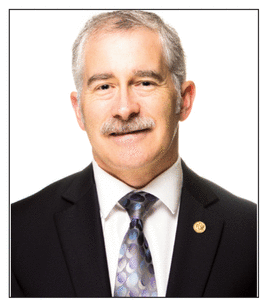
Douglas Doucette
A patient experience advisor was recently appointed to our regional pharmacy service. A retired layperson, she had no prior contact with pharmacists in hospital settings. I had the privilege of introducing her to many of our staff on a couple of site visits, which allowed me to witness her blossoming awareness of hospital pharmacy roles.
During her visits, she learned that not long ago, hospital pharmacists worked in subterranean departments focused almost entirely on dispensing medications and preparing sterile products, without any support personnel. The pharmacists ventured to patient wards only to investigate inventory discrepancies, retrieve missing order sheets, and deliver medications to patients going out on pass. Today, the profession has evolved to the point where hospital pharmacists serve on many patient care teams, providing drug information and collaborating to manage and monitor patients’ drug therapy with the goal of optimizing outcomes. These roles are supported by pharmacy technicians, who have taken on greater responsibility for medication distribution in health care institutions.
Our patient advisor was impressed with the degree of computerization and robotics in our departments, and with the skilled workforce overseeing these operations. Like many other modern hospital pharmacies, ours relies on commercial pharmaceuticals, packaging machines, and decision-support software for managing inventory and documentation and for reducing errors. These tools allow pharmacy teams to do their jobs more efficiently, but technology cannot be held responsible for clinical decisions.
The patient advisor and I moved from the central pharmacy to visit pharmacists in the intensive care unit, emergency department, and family medicine units. She was impressed to learn how pharmacy services have evolved, with pharmacists now able to prescribe medications and order tests. Transition to the regulation of pharmacy technicians and the integration of pharmacy students and residents into more direct patient care roles have helped our services grow further still.
Although pharmacists are perennially among the most trusted professionals in Canada, care should be taken to avoid complacency. Many pharmacy departments remain under-resourced and must prioritize which units or patients receive services. Many hospitalized patients do not receive comprehensive pharma ceutical care during their stay. Services cannot always be replaced during vacation or sick time. Most critical care areas have pharmacists available only on weekdays, despite the fact that patients experience drug therapy issues 24/7.
|
|
||
|
|
||
Hospital pharmacy teams can improve their ability to deliver high-quality care to each patient entrusted to their care through the following approaches:
Be patient-centred, by involving patients in decisions about care.
Be collaborative, by working with others in the patient’s circle of care.
Be visible, by being physically present when care decisions are made and by documenting pharmacy care plans in the medical record.
Advances in equipment, systems, and professional scope of practice have supported pharmacy in reaching its current place as a trusted and effective element of institutional health care in Canada. As a profession, let’s try to be consistent in efforts to educate other health care professionals, patients, and laypersons about the benefits of pharmacy services to improve patient care and health outcomes. This will help to maintain an element of pharmacy awareness year-round, not just during our annual “awareness” campaign.
Canadian Journal of Hospital Pharmacy, VOLUME 71, NUMBER 2, March-April 2018